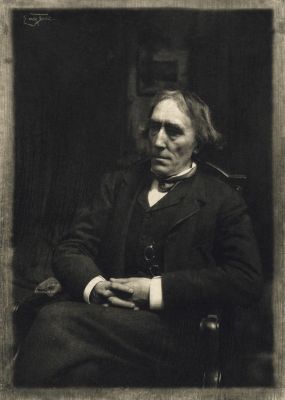
Title
Man in ArmorArtist
Eugene, Frank (American, 1865-1936)Publication
Camera Work XXXDate
1910Process
PhotogravureAtelier
F. Bruckmann Verlag, MunichImage Size
17.2 x 6.3 cm
Born in New York to immigrant parents, Eugene was one of many young German-Americans to travel to Munich to study at the Royal Bavarian Academy of Arts. Alfred Stieglitz and the influential art critic Sadakichi Hartmann promoted Eugene’s Pictorialist photographs in exhibitions and publications such as Camera Work Hartmann was essentially responsible for making Eugene’s photographs known internationally, even though he was openly critical of his artistic method. Hartmann considered Eugene’s depiction of the texture and color of fabrics to be his real achievement and one which lent his compositions a three-dimensional quality. According to Hartmann, Eugene was the first American pictorialist whose works achieved a convincing synthesis of painting and artistic photography. But despite his fascination with them, Hartmann also regarded Eugene’s works as limited and not very original iconographically, even as mere imitations of symbolist or Pre-Raphaelite paintings. On the other hand, in his emphasis on the silhouette of full length figures and his use of a narrow rectangular upright format which came close to the “hashira-e” of Japanese woodcuts, some of Eugene’s photographs show the influence of Japonaiserie. Successful photographs taken by Eugene with no retouching were regarded by Hartmann as pure chance, more the expression of the artist’s intuition, mood and vitality than the result of a conceptual procedure. As a convinced supporter of a purist photography (straight photography) Hartmann was to become a harsh critic of Eugene’s eccentric photographic method in the following years: “His method attracts by its novelty, by its purely artistic, almost colorist intentions. But he is too great a despiser of perspective and truth to be able to continually produce valuable works. “ [1]
Reproduced / Exhibited
Stieglitz, Alfred, Richard Whelan, and Sarah Greenough. Stieglitz on Photography: His Selected Essays and Notes. New York, NY: Aperture Foundation, 2000. p. 118
References
[1] Eugene, Frank, and Ulrich Pohlmann. Frank Eugene, the Dream of Beauty. Munich: Nazraeli Press, 1995. P. 45









